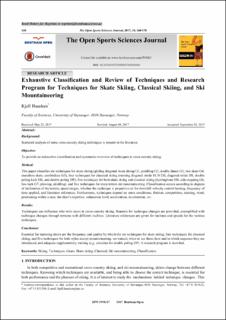| dc.description.abstract | Background:
Scattered analysis of some cross country skiing techniques is present in the literature.
Objective:
To provide an exhaustive classification and systematic overview of techniques in cross country skiing.
Method:
This paper classifies six techniques for skate skiing (gliding diagonal skate skiing G1, paddling G2, double dance G3, two skate G4, marathon skate, combiskate G5), four techniques for classical skiing (running diagonal stride RUN DS, diagonal stride DS, double poling kick DK, and double poling DP), five techniques for both skate skiing and classical skiing (herringbone HB, side-stepping G6, low tuck G7, plowing, skidding), and five techniques for steep terrain ski mountaineering. Classification occurs according to degrees of inclination of the terrain, speed ranges, whether the technique is propulsive or for downhill velocity control/turning, frequency of time applied, and literature references. Furthermore, techniques depend on snow conditions, friction, competition, training, wind, positioning within a race, the skier’s expertise, exhaustion level, acceleration, deceleration, etc.
Results:
Techniques can influence who wins races in cross-country skiing. Reasons for technique changes are provided, exemplified with technique changes through terrains with different inclines. Literature references are given for inclines and speeds for the various techniques.
Conclusion:
Essential for maturing skiers are the frequency and quality by which the six techniques for skate skiing, four techniques for classical skiing, and five techniques for both styles except mountaineering, are trained, when to use them, how and in which sequence they are introduced, and adequate supplementary training (e.g. crunches for double poling DP). A research program is sketched. | en_US |

